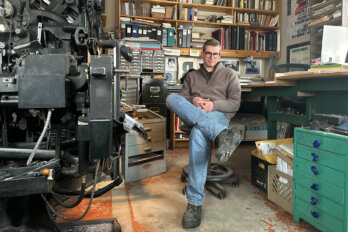I was born on an air force base on the Canadian Prairies the summer of the OPEC embargo. My father flew fighter jets for a living, flew them nearly every day of the working week for years at a stretch, burning jet fuel to roar through the sky faster than the speed of sound. If the sins of the father are visited on the son, then my carbon budget was surely blown before I could walk.
I spent my adolescence at CFB Cold Lake on the southern rim of the McMurray Formation in the mid-1980s, just after Imperial Oil began developing in situ deposits in the area. At my brother’s high school, off base in the nearby town of Grand Centre, Alberta, it was a common path for a teenage boy struggling in school to quit and go off to work as a rig pig, an unskilled labourer on an oil-drilling site. Sometimes it was said on the school grounds they’d gone off to the tar sands, which was the only term anyone in Cold Lake used for the industry in those days.
Now I live in Calgary, the corporate capital of Alberta’s vast oil patch. My wife grew up in the city, and my two children have known no other home. When my daughter was born, the congratulatory package of health care brochures and baby-product samples handed out on departure from the hospital included an invitation to plant a tree in her name in a grove maintained by BP. She attended the city’s lycée for a time, and one September we arrived to drop her off for the first day of school to find a new sign with the Total logo on it over the entrance; the company had recently made major oil sands investments, and the lycée had made a deal to guarantee spots in the school for the children of Total employees. I ran for parliament once, as a Green Party candidate in a 2012 by-election, and came surprisingly close to winning through the efforts of a volunteer team thick with oil-and-gas-sector employees.
I am dug in, is what I mean. I sit in a house warmed by natural gas and tap at a petrochemical polymer keyboard. I might prefer walking and trains to cars and airplanes, but I’m as fully complicit in the long rule of oil as anyone. As everyone. This is our world, and it is caught between one age and another, the fossil-fuelled High Modern and whatever comes after it in a world shaken by climate change. The only difference between the oil patch and anywhere else is that its complicity is so much more prominent on the landscape.
The Patch, after all, is a Canadian institution, an industrial cluster built by the collective will of several levels of government across many generations. It is a place where Canadians live their lives in a Canadian city like any other. The Patch is us.
We could begin there, on that middle ground, but for the trenches to either side. The Patch has become a battlefield, in some sense literal but primarily ideological, and our way forward runs through it. The battle that began there will come everywhere, if it hasn’t arrived already, because it’s a battle over how anyone who relies on fossil fuel—which is virtually everyone—will restructure their lives for a world with much less fossil fuel in it. The early reports from the Patch, frankly, aren’t promising. It is either Hiroshima or a wonder of the world, a vital economic engine or the most destructive project on earth, an essential commodity or dirty oil, Mordor or Fort McMoney. There is no nuance in this rhetoric, no room for compromise. These are ideological weapons in a zero-sum fight over complicity. The Patch’s opponents say all the complicity rests on the other side of the battlefield, with the corporate exploiters making billions by destroying the planet. Its defenders say there is no crime to be complicit in, or else that the crime is all the world’s.
There is no common ground. And that is how both sides lose.
As a nation, Canada aims for placid civility. It is polite and dull in the stereotypical version of the story. If its sociopolitical culture has a bias, it is toward mushy middle ground.
There is a way to summarize the long arc of Canadian history as a series of opt-outs, concessions, and compromises. Like any overly tidy historical device, this one hacks away some inconvenient underbrush and prunes any number of significant but tangential branches. But it’s a plausible through line all the same: The transactional collaboration between voyageurs and Indigenous peoples. The influx of British Loyalists unwilling to embrace the American Revolution. Robert Baldwin’s invitation to Louis-Hippolyte LaFontaine to run for a seat in Upper Canada after being bullied into withdrawing by rebellious mobs in Lower Canada—the first real political collaboration between French and English Canadians, which enshrined phrases like “historic compromise” and “moderate reformer” in Canada’s political lexicon. A Confederation deal that only went halfway, under duress, for fear of American encroachment. Middle-power status, and the Quiet Revolution, and official multiculturalism.
This arc has a dark shadow. The unsettled legacy of the 1973 Royal Proclamation and the Quebec Act, which enshrined English conquest but left room for the French to endure. The institutionalized hypocrisy of the Indian Act and the numbered treaties that annexed half a continent from Indigenous peoples who had no written legal tradition of land rights or private property. A nation whose economic foundations were built almost entirely on resource extraction but whose self-image would come to be coloured by pride in its tradition of conservation and stewardship in a vast hinterland.
Canada’s political culture is, in any case, cautious and consensus seeking. It was not designed for radical change or rapid transformation. It doesn’t do revolution. In many ways, it seems a poor fit to respond to the extraordinary challenge to the status quo posed by climate change, ill-suited to the total reimagination of the very foundations of modern civilization the crisis obliges.
But perhaps Canada’s mushy middle is the best place to build the kind of broad, lurching, jerry-built consensus that long-term action on climate change requires. There is a paradox in Canada’s relationship with its natural spaces that is older than the country itself, an awkward two-step attempting to balance the national economy’s deeply exploitive disposition toward resource development with a civil society increasingly oriented toward a gentler and more custodial role of sound environmental stewardship. This is the core contradiction between the High Modern and Anthropocene definitions of progress, and it has been embedded deeply in the national character. Or, to put it less charitably, Canada has always tried to have it both ways.
The tension between the two understandings—the presumption of balance—has snapped under the pressure of the Patch’s long boom. Climate change has called into question the very foundations of Canada’s economy, spilled sand in the prosperous lubricant of its placid civil society, distorted the historic good-guy image in the national mirror. In response, Canada has grandstanded, backtracked, equivocated, and dissembled. Only once the Patch became a global smear on the nation’s reputation did Canadians attempt to stare themselves full in the face of climate reality’s mirror for the first time. It was not a pretty image. But then, in the Anthropocene, whose is?
Maybe because the deep contradictions between the High Modern and Anthropocene definitions of progress have come into their highest relief to date in Canada—in the Patch—Canadians have begun to see more clearly than most how complex the reconciling of those definitions will be. This is the Patch’s great lesson: the climate crisis took generations to create. It will take a generation or more to solve. It was unintentional, arising from what was understood to be the most vital job of a modern industrial society—fuelling its engines. It won’t be solved in a campaign, and the solutions aren’t anywhere near simple enough to fit on a protest placard or a billboard.
I’ve toured wind farms in Denmark and solar-powered villages in Thailand. I’ve seen wondrously efficient architectural marvels in India and wholly self-sufficient zero-emissions communities on the coast of Scotland and in the New Mexican desert. I’ve interviewed brilliant engineers and tireless entrepreneurs and crafty old politicians working on the design of that low-carbon world. In the south of Germany, I once sat with an architect in a townhouse that generated more energy than it used from nothing but the sun, and I heard about how he had built it, how he’d built a whole community of them. Then I thanked him for his time and walked the streets between the rows of the townhouses he’d designed and wondered why houses were still being built any other way.
In recent years, a slogan has emerged, popular among renewable-energy advocates and climate-change campaigners: 100 Percent Possible. An entire modern society, running exclusively on emissions-free energy—this is the rallying cry. I’d been chanting my own version of the same mantra for years. I had once been convinced that the mounting evidence and compelling case studies could win the day pretty much on their own. The concepts had been proven. They could be copied—would be copied—and achieve the same successes. So it would go, on and on, project by project, and policy by policy, energy and then transportation and then urban design, until the whole impossibly scaled mess of climate change was surmounted. Now that people knew what was possible, we would hit critical mass and the tide would shift. Any day now.
In retrospect, I made a single monumental mistake: I’d discounted politics. It’s an error I still see in the circles where the 100 Percent Possible slogan and others like it—Keep It in the Ground, for example—hold sway. Politics, with whatever ugly baggage comes attached to it, is the necessary vehicle for collective action in democratic societies. Politics is how Karl Clark funded research to develop hot water separation process for bitumen, the way Howard Pew was convinced to invest millions of dollars of Sun Oil’s money in a bitumen mine, the way Syncrude found funding after its financing nearly collapsed, the means by which a tax and royalty regime was installed to trigger the long boom. And now politics must find its way to a middle ground, a plateau and long fade in the Patch as the technology and economics and political will come together to build that low-carbon world. And it must do so, alas, with a battleground as its starting point.
There is no set of policies so flawless, and no social movement of such undeniable force, that the industrial order—an order that spent two hundred years building a system to justify and replicate itself—will simply crumble away. Climate politics is already more muddled than most kinds, and energy policy is a morass of vested interests. The transition from one energy regime to another will be managed by the same tangled nest of hypocritical, compromised, self-interested politics that runs the enormous machine today. And so, here in Canada, there are both carbon prices and pipeline approvals—messy Canadian compromises, the best we can manage to date.
In 2014, a British campaigner named George Marshall published a book called Don’t Even Think About It: Why Our Brains Are Wired to Ignore Climate Change. He’d spent years talking to social anthropologists and behavioural psychologists, as well as activists for and against action on climate change, and he’d uncovered a cognitive tic that he was convinced explained our conflicted, counterproductive collective response.
“The things that we pay immediate attention to are things that are here and now,” Marshall said in an interview. “Things where there is a certainty of imminent threat, especially those that are caused by an identifiable enemy with the intention to cause us harm. And the problem is climate change has none of these qualities. Climate change appears to be in the future, uncertain, distant in both time and place. And possibly, above all, it suffers from the fact that there is no clear enemy with the intention to cause us harm. In fact, if anyone is responsible, it is ourselves. And that generates another level of anxiety and moral challenge for us that makes us want to push this issue even further away into the far distance, and not to deal with it.”
There is an entire niche in the scientific literature alongside Marshall’s book. There are studies looking at the cognitive biases at work, polemics on how to “reframe” climate change as a more positive or more immediate or more conservative issue. In social psychology, there is a concept known as a normative threat: a perceived challenge to a social group’s moral order seen as so dangerous that it triggers something like an all-out-war response. Under a normative threat, a social group will lurch away from new ideas and open dialogue, demanding total and forceful rejection. This is the result of the moral challenge Marshall talks about. Action on climate change commensurate with the scale of the problem promises to change how we light and heat our houses, how we travel daily to work, what kind of things we can buy and eat, and what they cost. For a significant portion of the general public in Canada or anywhere else, action on climate change is a normative threat. In the Patch, beyond the necessary PR-minded compromise stances of the executives at some of the biggest companies, it is most certainly seen this way: the climate activists would take away everything they cherish—their jobs, their community, their industry—if they could.
Fighting climate change is not a campaign. It won’t be beaten. We won’t “win.” We will either change our daily lives and the industrial basis of our societies, or we won’t, over years and decades. In mean little increments. Through fleeting elation and hard compromise.
When the Patch’s boosters say they are simply supplying a product everyone uses every single day, they are not wrong. When the prime minister says, “No country would find 173 billion barrels of oil in the ground and just leave them there,” he’s not wrong. When anti-pipeline protesters say some of that oil has to stay in the ground, they’re not wrong. When Indigenous people say they’ve never been properly consulted about what those pipelines and bitumen mines are doing to their land, they’re not wrong.
There’s more to the debate, though, more to the way forward, than being right. A thing of such scope and power and wealth as the Patch doesn’t go away overnight or in a few years. Building the entire industrial basis of modern society on a new energy regime does not happen overnight or in a few years. We will have the Patch for decades. It is a fixture on the Canadian landscape. It employs tens of thousands. It is a truly national project or else the term has no meaning.
We have all benefited. We are all stakeholders. We are all complicit.
Copyright © 2017 by Chris Turner. From The Patch: The People, the Pipelines and the Politics of the Oil Sands, published by Simon and Schuster Canada, Inc. Printed with permission.





